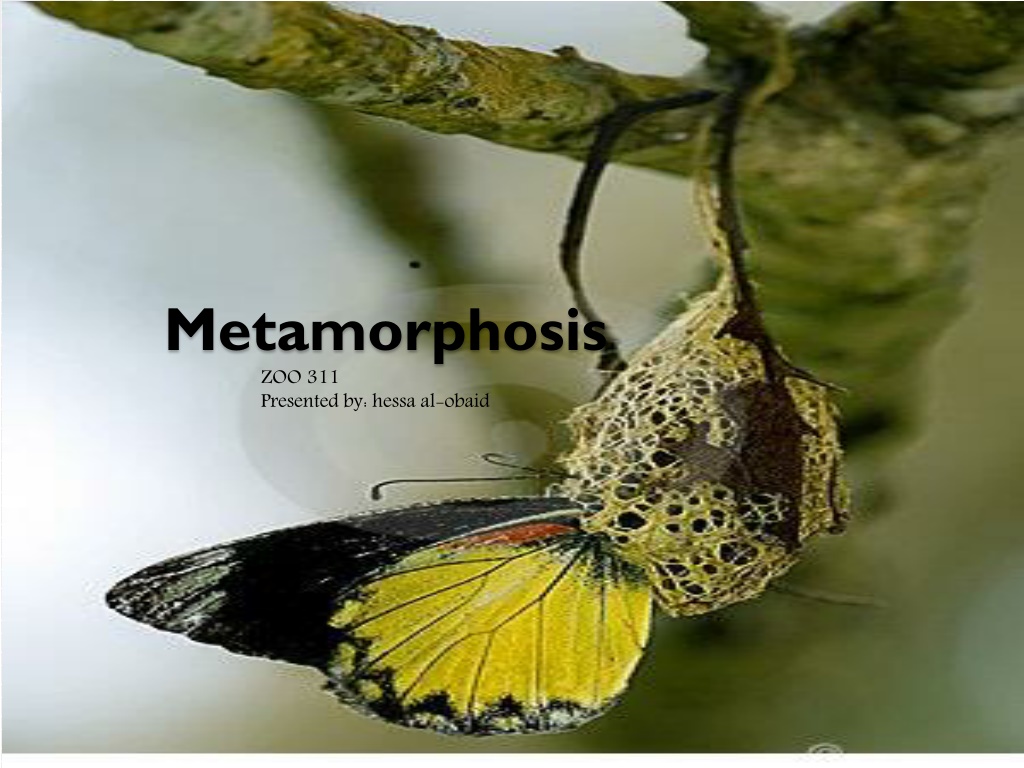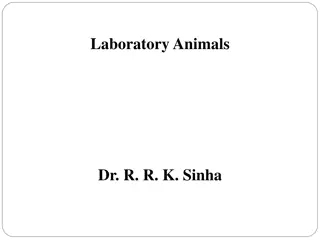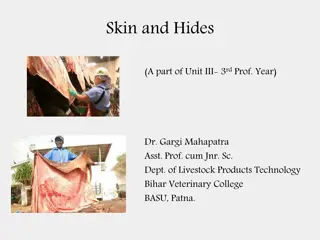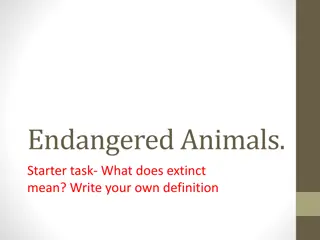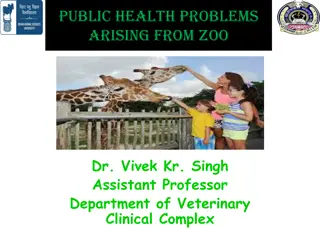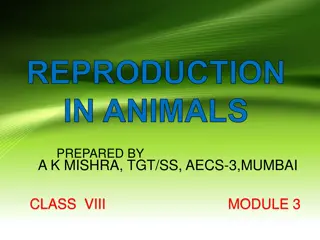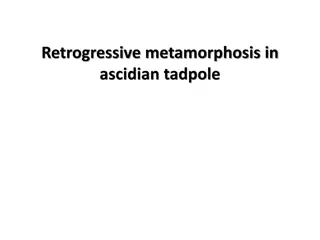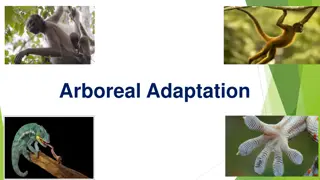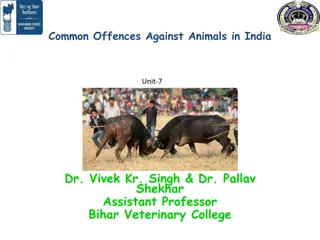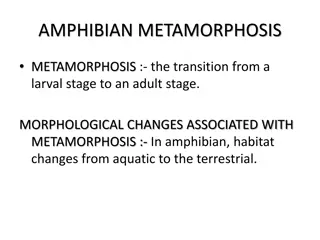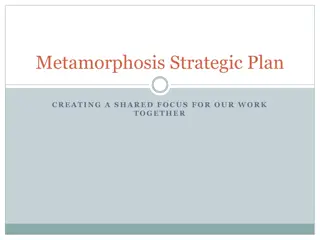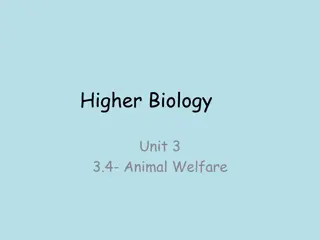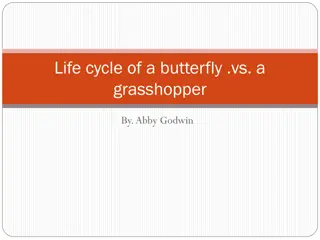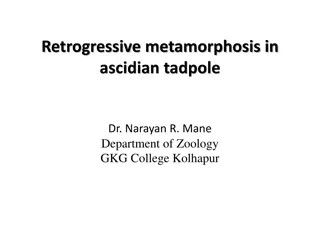Understanding Metamorphosis in Animals
Exploring the fascinating process of metamorphosis in animals, where they undergo significant physical changes after birth or hatching. Discover different types such as ametabola, hemimetabolism, and complete metamorphosis, each with distinct stages. From insect eggs to the transformation into adults, this article delves into the diversity and wonder of biological development in the animal kingdom.
Download Presentation

Please find below an Image/Link to download the presentation.
The content on the website is provided AS IS for your information and personal use only. It may not be sold, licensed, or shared on other websites without obtaining consent from the author. Download presentation by click this link. If you encounter any issues during the download, it is possible that the publisher has removed the file from their server.
E N D
Presentation Transcript
Metamorphosis ZOO 311 Presented by: hessa al-obaid
Metamorphosisis a biological process by which an animal physically develops after birth or hatching, involving a conspicuous and relatively abrupt change in the animal's body structure through cell growth and differentiation.
Types of Types of Metamorphosis Metamorphosis
Ametabola Ametabola Are Are a a division are are wingless wingless and any any metamorphosis, metamorphosis, but hatch hatch from from the the egg same sameform formthey theykeep their theirlife life.. E E..x x..Apterygota Apterygota(collembola division of of insects and do do not insects which not undergo undergo but which egg nearly nearly in in the the keepthroughout throughout which which collembola) )
Hemimetabolism Hemimetabolism( (incomplete metamorphosis incomplete metamorphosis) ) Is a term used to describe the mode of development of Is a term used to describe the mode of development of certain insects that includes three distinct stages: the certain insects that includes three distinct stages: the egg nymph nymph and the and the adult stage adult stage. . These groups go through gradual changes; there is no These groups go through gradual changes; there is no pupal stage. stage. The nymph often somewhat resembles the adult stage but The nymph often somewhat resembles the adult stage but lacks wings and functional reproductive organs. lacks wings and functional reproductive organs. E.x E.x. . Exopterygota Exopterygota. . egg, , pupal
Complete metamorphosis The eggs hatch into larvae The eggs hatch into larvae molt several times several times , turn , turn to t pupa stage then to adult stage then to adult form. Each Each stage of the life cycle stage of the life cycle egg, larva, pupa, and adult egg, larva, pupa, and adult looks different from the others. looks different from the others. Entomologists call these insects Entomologists call these insects holometabolous holometabolous. . Such as Such as Endopterygot Endopterygot molt to t pupa form.
Insect eggs Insect eggs have various shapes. Some are conical, others are elliptical or hemispherical. The egg covered with a shell or varying thickness color and shape. Some eggs are laid singly in or plants, or in the soil, others laid in groups. The eggs are enclosed in an outer egg case or ootheca.
Southern green stinkug ,Nezara viridula
Larva The The larva is the stage which hatch from eggs in insect with larva is the stage which hatch from eggs in insect with compleat compleat metamorphosis. Larvae take different forms and is metamorphosis. Larvae take different forms and is divided into three main types divided into three main types:: Apodous Oligopod Polypod Scarabaiform Campodeiform Encephalous Acephalous Hemicephalous
1-Polypod It possesses It possesses 3 3 pairs of jointed legs (true legs) and pairs of jointed legs (true legs) and numerous abdominal numerous abdominal prolegs prolegs, with cylindrical body. Well Well- -defined segmentation. Usually sluggish and live defined segmentation. Usually sluggish and live near there food. Order near there food. Order- -Lepidoptera Lepidoptera , with cylindrical body. Photo shows a caterpillar
2- Oligopod Presence of well Presence of well- -developed thoracic limbs. Pairs of developed thoracic limbs. Pairs of abdominal cerci. abdominal cerci. Photo shows a ladybird beetle larva
There are two type of Oligopod 2 2- -1 1- - Campodeiform Campodeiform This type of larvae look elongated, flattened, This type of larvae look elongated, flattened, predatory and active. predatory and active. Well Well- - sclerotized sclerotized body, with body, with prognathous Legs are long and not reduced, with a pair of Legs are long and not reduced, with a pair of terminal appendages. terminal appendages. E.x E.x. Order : . Order : Neuroptera Neuroptera prognathous head. head.
2 2- -2 2- - Scarabaiform Scarabaiform Body soft, cylindrical and C Body soft, cylindrical and C- - shape. Thoracic legs, no Thoracic legs, no cadual appendages. appendages. Most of them move slowly. Most of them move slowly. It is commonly called "grub" It is commonly called "grub" coleoptera shape. cadual process or process or coleoptera
3-Apodous Larva with no legs and with reduced head Larva with no legs and with reduced head that requires maternal care or deposition in that requires maternal care or deposition in or on food source. or on food source. Common in hymenoptera, Common in hymenoptera, diptera coleopteran coleopteran.. There are There are three forms three forms of the larvae depends on the growth of head rings: on the growth of head rings: diptera and some and some of the larvae depends
3 3- -1 1- - Encephalous Encephalous With well With well- - sclerotized (Mosquito larvae) (Mosquito larvae) 3 3- -2 2- - Hemicephalous Hemicephalous With a reduced head capsule which can be retraced With a reduced head capsule which can be retraced within the thorax. within the thorax. E.x E.x. . Tabanus Tabanus Larva sclerotized head capsule. head capsule. E.x E.x. . Nematocera Nematocera Larva
3 3- -3 3- - Acephalous Acephalous Without a head capsule. ( Without a head capsule. (Musca Musca larva). larva).
Pupae The The papae holometabolous holometabolous insect. During this stage the During this stage the unsect and is quiescent. i.e., develops from the egg through and is quiescent. i.e., develops from the egg through the larva and the pupa stages to the adult. the larva and the pupa stages to the adult. The following types of pupae are recognized: The following types of pupae are recognized: papae is the resting inactive is the resting inactive instar insect. instar in all in all unsect is incapable of feeding is incapable of feeding
Obtect, the appendages are visible but they are closely glued to the body. The pupae is coverd with a tight- fitting transparent skin and only the posterior end of the abdomen is movable. E.x. Lepidoptera
Exarate, with the appendages free and not with the appendages free and not glued to the body; such as pupae of the Western glued to the body; such as pupae of the Western honey bee. honey bee. E.x E.x. Hymenoptera . Hymenoptera
Coarctate, the appendages are not the appendages are not visibile pupae is enclosed in pupae is enclosed in apuparium from the last larval skin. Found in certain from the last larval skin. Found in certain Diptera Diptera visibile. The which is made . The apuparium which is made
